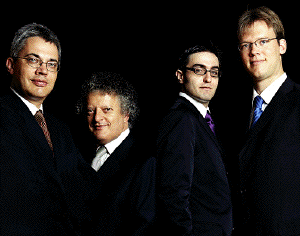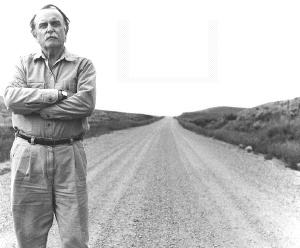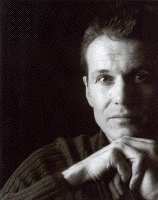|
Arditti Quartet
(UK)

The Arditti Quartet enjoys a
world-wide reputation for their spirited and
technically refined interpretations of contemporary
and earlier 20th century music. Several hundred
string quartets and other chamber works have been
written for the ensemble since its foundation by
first violinist Irvine Arditti in 1974. These works
have left a permanent mark on 20th century repertoire
and have given the Arditti Quartet a firm place in
music history. World premieres of quartets by
composers such as Birtwistle, Cage, Carter, Dillon,
Ferneyhough, Gubaidulina, Harvey, Hosokawa, Kagel,
Kurtag, Lachenmann, Ligeti, Nancarrow, Reynolds,
Rihm, Scelsi, Stockhausen and Xenakis show the wide
range of music in the Arditti Quartet's repertoire.
The ensemble believes that close collaboration with
composers is vital to the process of interpreting
modern music and therefore attempts to work with
every composer it plays.
The players' commitment to educational work is
indicated by their masterclasses and workshops for
young performers and composers all over the world.
From 1982 to 1996 the quartet's members were resident
string tutors at the Darmstadt Summer Courses for New
Music.
The Arditti Quartet's extensive discography now
features over 130 CDs. 42 discs have been released as
part of the ensemble's continuing series on the
French label
Naïve Montaigne. The series presents numerous
contemporary composer features as well as the first
digital recordings of the complete Second Viennese
School's string quartet music. Stockhausen's infamous
Helicopter Quartet is to be found here. As well
as many composer portraits recorded in their
presence, the complete quartets of Luciano Berio were
recorded shortly before his death. Latest releases
include music by Ades, Cage, Fedele, Finsterer,
Frith, Ingolfsson, Neuwirth and Paredes.
Over the past 25 years, the ensemble has received
many prizes for its work. They have won the Deutsche
Schallplatten Preis several times and the Gramophone
Award for the best recording of contemporary music in
1999 (Elliott Carter) and 2002 (Harrison Birtwistle).
The prestigious Ernst von Siemens Music Prize was
awarded to them in 1999 for "lifetime achievement" in
music.
|
|
|
Pascal DUSAPIN
(FR)
was born in Nancy in 1955, and
studied fine art and science, art and aesthetics at
the Sorbonne in Paris.
Between 1974 and 1978 He
attended the seminars of Iannis Xenakis. 1981-1983 He
was a scholarship holder at the Villa Medici in Rome.
1993-1994 He was composer-in-residence with the
Orchestre National de Lyon.
Right from the beginning of his career as a composer,
he was the recipient of numerous prizes and
distinctions: in 1977, he received an award from the
Fondation de la vocation; in 1979, he won the Hervé
Dugardin Prize (SACEM); in 1993, the Prize of the
Académie des Beaux-Arts; in 1993, the Prix du
Syndicat de la Critique (Critics' Circle Award); in
1994, the SACEM Prize for Symphonic Music; in 1995,
the French Ministry of Culture awarded him the Grand
Prix National de Musique; and finally, he won a
Victoire de la Musique in 1998 for a CD recorded by
the Orchestre National de Lyon, and another one in
2002, as "Composer of the Year".
He has written many pieces for ensemble, for
orchestra, and most especially for soloists and for
chamber formations, a domain in which he excels
thanks to his intimate knowledge of the subtleties of
individual instruments. Pascal Dusapin's catalogue at
present consists of around 70 works, including 14 for
solo instruments, 24 chamber pieces, 13 works for
ensemble and 14 works for symphony orchestra.
Autumn 2002 saw the first performances of A quia, a
concerto for piano and orchestra, and the complete
cycle of his Sept études for piano.
He has also
written four operas:
- Roméo & Juliette (1985-88) - Premiered in
Montpellier in 1989
- Medeamaterial (1991) - Premiered in Brussels in
1992
- La Melancholia (1991) - Premiered in Paris
(Châtelet) in 1992
- To be sung (1992-93) - Premiered in Nanterre in
1994
Perelà uomo di fumo, commissioned by the Opéra
National de Paris, was premiered at the
Opéra-Bastille on 24 February 2003, conducted by
James Conlon in a production by Peter Mussbach.
"Pascal Dusapin's creative work is
nourished by an exceptionally wide culture, which
takes in literature, philosophy, and poetry, and
ranges across the centuries from the works of
Greco-Roman antiquity to the most modern writers. One
need only read the list of titles of his works, and
the texts used in those that require vocal
participation, to measure the breadth of his
knowledge.
The world comes to him from all sides, and
one may also observe from time to time, between the
staves of his manuscript scores, annotations dealing
with the immediate history of our daily lives."
(Brigitte Massin) Pascal
Dusapin's works are published by Editions Salabert.
|
|
|
Helmut LACHENMANN
(GER)
was born in Stuttgart and after
the end of the Second World War (when he was 11)
started singing in his local church choir. Showing an
early aptitude for music, he was already composing in
his teens. He studied piano with Jürgen Uhde and
composition and theory with Johann Nepomuk David at
the Stuttgarter Musikhochschule from 1955 to 1958 and
was the first private student of the serialist
composer Luigi Nono in Venice from 1958 to 1960. He
also worked briefly at the electronic music studio at
the University of Ghent in 1965, but thereafter
focused almost exclusively on purely instrumental
music.
Lachenmann has referred to his compositions as
musique concrète instrumentale, implying a musical
language that embraces the entire sound-world made
accessible through unconventional playing techniques.
According to the composer, this is music "in which
the sound events are chosen and organized so that the
manner in which they are generated is at least as
important as the resultant acoustic qualities
themselves. Consequently those qualities, such as
timbre, volume, etc., do not produce sounds for their
own sake, but describe or denote the concrete
situation: listening, you hear the conditions under
which a sound- or noise-action is carried out, you
hear what materials and energies are involved and
what resistance is encountered". His music is
therefore primarily derived from the most basic of
sounds, which through processes of amplification
serve as the bases for extended works. His scores
place enormous demands on performers, due to the
plethora of techniques that he has invented for wind,
brass and string instruments.
His more important works include the music theatre
work Das Mädchen mit den Schwefelhölzern (1990-96,
after, Hans Christian Andersen, Leonardo da Vinci and
Gudrun Ensslin), the orchestral pieces Schwankungen
am Rand (1974-75, for eight brass, two electric
guitars, two pianos, four thunder sheets, and 34
strings), Accanto (1975-76, for clarinet, large
orchestra and tape) and NUN (1997-99, for flute,
trombone, male chorus, and large orchestra), the
ensemble works Mouvement (- vor der Erstarrung)
(1982-84, for three ad hoc players and 14 players)
and "...zwei Gefühle...", Musik mit Leonardo (1992,
an excerpt from Das Mädchen mit den Schwefelhölzern,
after Leonardo da Vinci, for two speakers and 22
players) and three string quartets (Gran Torso, 1971,
revised 1976, 1988; Reigen seliger Geister, 1989;
Grido, 2001), as well as other orchestral, ensemble
and chamber works and six piano pieces.
He has regularly lectured at Darmstadt since 1978 and
important among his many positions as a teacher was
his term as professor of composition at the
Stuttgarter Musikhochschule from 1981 to 1999. He is
also noted for his many articles, essays and
lectures, many of which appear in Musik als
existentielle Erfahrung (Music as Existential
Experience) Breitkopf & Härtel, Wiesbaden, 1996).
In November 2006 Lachenmann visited the Royal College
of Music's week-long festival of his music.
|
|
|
Alvin LUCIER
(USA)

A trailblazing force in
psycho-acoustic music, avant-garde composer and
performer Alvin Lucier was born in Nashua, New
Hampshire in 1931; educated at Yale and Brandeis, he
also spent two years in Rome on a Fulbright
Scholarship before returning to Brandeis in 1962 to
teach and conduct the university's chamber chorus.
His breakthrough composition, Music for Solo
Performer (1964-65) for Enormously Amplified Brain
Waves and Percussion, was the first work to feature
sounds generated by brain waves in live performance;
Biological stimuli played an increasing role in
Lucier's subsequent work as well, most notably
through his notation of performers' physical
movements.
Acoustical phenomena, meanwhile, was the subject of
1970's landmark I Am Sitting in a Room, in which
several sentences of recorded speech were
simultaneously played back into a room and
re-recorded there dozens of times over, the space
gradually filtering the speech into pure sound.
1980's "Music on a Long Thin Wire"
was a further extension of Lucier's fascination
with the physics of sound - a conceptual piece
featuring a taut 50-foot wire passed through the
poles of a large magnet and driven by an
oscillator, the amplified vibrations yielded
beautifully ethereal results.
A professor at Wesleyan University from 1970 onward,
Lucier's later works additionally included a number
of sound installations as well as works for solo
instruments, chamber ensembles, and orchestra.
|
|
|
Marco STROPPA (I,
F)

Composer, researcher and
professor, Marco Stroppa was born in Verona on
December 8, 1959. He undertook a range of musical
studies at the Conservatories of Verona, Milan and
Venice. He also studied computer music, cognitive
psychology and artificial intelligence at the Media
Laboratory of the Massachusetts Institute of
Technology on a Fulbright Scholarship in 1984-86.
Between 1980 and 1984 he worked at the computer music
centre (CSC) of the University of Padua (Italy),
where he produced his first mixed piece, Traiettoria,
for piano and computer.
In 1982 Pierre Boulez invited him to leave Italy for
Paris where he worked as a composer and researcher at
IRCAM (Institute de Recherche and Coordination
Acoustique/Musique). He was appointed as head of the
Music Research Department in 1987, but resigned in
1990 to fully concentrate on composition and
research. He also taught regularly at IRCAM since his
arrival there and his constant contact with this
institution has been fundamental to his musical
education and work as a composer until these days.
Mr. Stroppa has worked in Paris and lived near Paris
since 1982. In 2005 he became a French citizen.
In 1987 Mr. Stroppa founded the composition and
computer music workshop at the International Bartók
Festival in Szombathely, Hungary.
He taught composition at the Conservatoire National
Supérieur de Musique in Paris as a successor to
Gerard Grisey and since 1999 he has been full
professor of composition and computer music at the
University of Music and Performing Arts
(Musikhochschule) in Stuttgart, as successor to
Helmut Lachenmann.
Mr. Stroppa composed for both acoustical instruments
and new media. His repertoire includes works for
concerts, one music drama, two radio operas and
various special projects. He is often inspired by the
personal contact with performers (among others,
Pierre-Laurent Aimard, Cécile Daroux, Florian
Hölscher, Thierry Miroglio, Jean-Guihen Queyras,
Benny Sluchin).
His keen interest in sound and space has often led
him to rethinking the placement of the instruments on
stage so as to achieve a spatial dramaturgy that will
be revealed and highlighted by the unfolding of the
music.
Among his previous works, we mention: Traiettoria
(1982-84) for piano and computer, Hiranyaloka
(1993-4) for orchestra, Proemio (1990), in cielo in
terra in mare (1992) two radio operas, Zwielicht
(1998) for double bass, two percussion players,
electronics and 13-D sound projection. He is
currently composing a piece for the Orchestre de
Paris (Ritratti senza volto), a concerto for cello
and orchestra (And one by one we drop away) and a
concerto for piccolo and string orchestra (No
Boughs).
|
|
|
Iannis XENAKIS
(Gr)
was born in 1922 into a Greek
family residing in Braila, Romania. The sense of
being an “outsider” has remained integral to his
identity, as the title of a recently published book
of interviews signals: "il faut être constamment un
immigré." Forced to escape his country, Xenakis ended
up in Paris, wanting to study music, but earning a
living working as an engineering assistant for Le
Corbusier.
His creative and intellectual intensity attracted the
attention of both the reknowned architect, who
delegated architectural projects to him in spite of
his lack of professional training, and the composer
and pedagogue Olivier Messiaen, who saw in the music
he was struggling to produce in isolation an
originality deserving of encouragement. Xenakis had
his first major succès du scandale with the premiere
of Metastasis at the Donaueschingen Festival in 1955,
and by 1960, he was able to devote himself entirely
to composition.
Critical of other developments in contemporary music
at the time, dominated by the serialists (the
"Darmstadt school") such as Pierre Boulez, Luigi
Nono, and Karlheinz Stockhausen, Xenakis followed his
own path, aided by his background in mathematics,
engineering and design and by his interest in complex
sonic phenomena (rainstorms, street demonstrations,
etc.). He incorporated probability theory into his
compositional approach, as a means of generating and
controlling large-scale events composed of massive
numbers of individual elements. He also adopted the
sonic entity (texture) as the primary material for
the construction of musical form (rather than themes
or pitch structures).
For over 40 years, Xenakis created a steady stream of
remarkable works and his impact on contemporary music
has been of crucial importance. Along with his
acoustic works, he has produced a number of important
electroacoustic pieces, and a series of multimedia
creations involving sound, light, movement and
architecture (polytopes). In the domain of computer
music, Xenakis was a pioneer in the area of
algorithmic composition, and has also developed an
approach to digital synthesis based on random
generation and variation of the waveform itself. In
addition, he designed a computer system utilizing a
graphic interface (the UPIC), which has proven to be
a liberating, provocative pedagogical tool as well as
a powerful environment for computer composition.
Iannis Xenakis died on 4 February 2001 at age 78. His
last completed composition, O-Mega, for solo
percussion and ensemble was premiered at the
Huddersfield Festival of Contemporary Music in 1997.
In December 2000, the world premiere of a couple of
his very early works, from the Anasteria triptych
based on an ancient Greek rite, took place in
Germany, almost 50 years after they were composed
(1952-1953).
|
|


